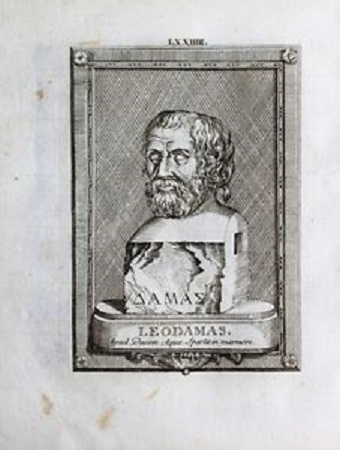
Leodamas of Thasos

Leodamas of Thasos (c. 380 BC) was a Greek mathematician and a contemporary of Plato, about whom little is known.
Leodamas is treated as a contemporary of Plato in the summary of the history of geometry which Proclus reproduces in his commentary on the first book of Euclid’s Elements:
At this time also lived Leodamas of Thasos, Archytas of Tarentum and Theaetetus of Athens, by whom the theorems were increased in number and brought together in a more scientific grouping.1
Thasos, the birthplace of Leodamas, is an island in the northern Aegean off the coast of Thrace; but it would appear from the linking of his name with that of Archytas and Theaetetus that he spent his productive years in the Academy at Athens. This association with Archytas and Theaetetus suggests that he must have been a considerable mathematician; but the only other fact known about him is that Plato, according to Diogenes Laertius, “explained” (∊ἰσηνήσατo)to him the method of analysis2 or, according to Proclus, “Communicated” (παρ∊δ∊́δωκ∊ν) it to him3. Proclus describes analysis as carrying that which is sought up to an acknowledged first principle; he says it is the most elegant of the methods handed down for the discovery of lemmas in geometry, and he adds that by means of it Leodamas discovered many things in geometry.4 These passages have led some to suppose that Plato invented the method of mathematical analysis, but this is possibly due to confusion with Plato’s emphasis in the Republic on philosophical analysis. Mathematical analysis is clearly the same as reduction, of which Hippocrates had given a notable example in the reduction of the problem of doubling the cube to that of finding two mean proportionals; and the method must have been in use even earlier among the Pythagoreans.5
Notes
1. Proclus, In primum Euclidis, Friedlein ed. (Leipzig, 1873, repr. Hildesheim, 1967), p. 66.14-18.
2. Diogenes Laertius, III.24. If this sentence is to be read in conjunction with the one preceding, Diogenes’ authority is Favorinus.
3. Proclus, op. cit., p. 211.21-22.
4. The fact that at this point Proclus waxes so eloquent about the merits of analysis is regarded by T. L. Heath, in A History of Greek Mathematics, I (Oxford, 1921), 120, as proof that he could not himself have been the author of the summary of geometry, and it is virtually certain that the ultimate source of this part of the summary is Eudemus.
5. In the same passage Diogenes Laertius, relying on Favorinus, attributes to Plato the first use of the word “element”— which is obviously untrue, since Democritus must have used it before him.
BIBLIOGRAPHY
See Kurt von Fritz, “Leodamas,” in Pauly-Wissowa, Supp. VII (Stuttgart, 1940), cols. 371-373.
[1]
Sources
[1] "Encyclopedia.com" by Ivor Bulmer-Thomas
Our Mobile Application
Check out Our Mobile Application "Ancient Greece Reloaded"


